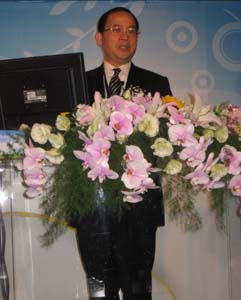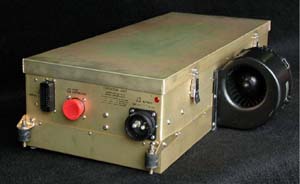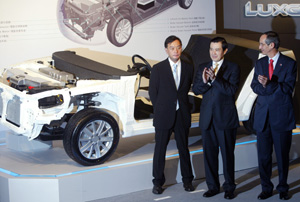HAITEC Senior VP C.C. Lee Sheds Light on EV Development in Taiwan
2009/06/23 | By Quincy LiangPerhaps fortuitously timed, when the global car-making sector is lurching and starting amid the recession, the 2009 Taipei International Automotive Electronics Forum (TIAEF), simultaneously held alongside the Taipei International Automobile Electronics Show (AutoTronics Taipei) and Taipei Int'l Auto Parts & Accessories Show (Taipei AMPA) saw Lee Chun-chong, senior vice president of Hua-chuang Automobile Information Technical Center Co. Ltd. (HAITEC) shed promising light on Taiwan's electric-car development and its future prospects.


Lee, long-time R&D chief at Yulon Motor Co., one of the largest carmakers on the island boasting the strongest homegrown R&D capability among local counterparts, was recruited by HAITEC, a new subsidiary under the Yulon Group, which was established to be the R&D arm for the LUXGEN, a new, fully-local brand created by Yulon to break into the global market. The HAITEC, a small-scale culmination of Taiwan's automotive technologies achieved by tapping, integrating available resources related to development and manufacturing of automobiles in Taiwan and worldwide.
In his keynote speech "The Full Performance Electric Vehicle R&D Project in Taiwan," Lee reveals how far electric car development has gone in Taiwan, as well as the program's future.

Several groups are involved in building electric cars in Taiwan, Lee said, including the Yulon Group, HAITEC, a group of parts suppliers, and various R&D teams worldwide. The groups have been working on different aspects of the program as key technology development, clean electric-vehicle development, business model development, and partnership with the energy industry, all of which are inter-related and achieve synergy.
According to Lee, the key-technology development has been moving forward in conjunction with the development of car platforms, key systems, components, with suppliers offering strong support. The next-phase of clean electric-vehicle development, advancing from key technology development, is driven by global trends in future technologies, as well as AC Propulsion Inc., a major California-based electric-vehicle solution provider.
The third phase or the business model, Lee said, is mapped out based on considerations of retail price, operational cost, consumer behavior, as well as developed electric-vehicles and infrastructural support from the energy industry, as the installation of plug-in refill stations.
Green Motivators
Governmental policies, especially in industrially advanced nations, are helping to promote the development of EVs, Lee said. For example, the increasingly demanding emissions standard Euro 5 in Europe to be effective by 2010 would clearly raise production costs of traditional internal combustion engine (ICE) vehicles; and the carbon dioxide (CO2) reduction regulations and energy-saving requirements in increasing number of nations are also pushing up ICE-vehicle costs.
Some industrially advanced nations, Lee said, are demanding vehicles to emit only 120g CO2 per kilometer, or fuel efficiency of 20 km-per-liter of gasoline in the near future, performance only achievable by smaller and lighter cars, hence forcing automakers to invest in improving fuel efficiency or building EVs. The ever-decreasing global crude-oil reserve and rising cost of tapping such reserves are also threatening traditional ICE cars.
Next 20-30 Years
"Pure EV and plug-in hybrid electric vehicle (PHEV) will lead the development of energy-saving vehicles in the next 20 to 30 years," Lee said confidently. "Because EV and PHEV technologies are quite mature now, while our globe can no longer wait for another 10 to 20 years for fuel-cell technology to mature. That means, EVs and PHEVs must become market mainstream in the next 20 to 30 years."
"Yulon understands clearly that the LUXGEN brand has to be 'different' enough to compete against established counterparts, so we have a very clear branding position: to create product feature and advantage. Every LUXGEN model, no matter EV, PHEV, or ICE car, integrates all available resources in Taiwan's information technology (IT), automotive, and energy technology (ET).
All major global automakers are planning to launch EV/PHEV products from 2009 to 2012 to get a foothold in the trendy market, Lee said, including Tata, BYD, Mitsubishi, Subaru, Nissan, Volkswagen, Mercedes-Benz, Renault, Citroen/Peugeot, Toyota, Fiat, Audi, BMW, GM, Ford, and Opel.
Teamwork
The LUXGEN EV integrates key parts and components as well as the most advanced technologies from international suppliers and technology developers, Lee said. In other words, HAITEC brings together the best efficiently to build the LUXGEN EV.
"We have many key-parts suppliers in Taiwan who supply quality and advanced products to our international partner AC Propulsion, including motors, power electronic units, battery packs, battery management systems (BMS), vehicle management systems (VMS) etc."
"The tie-up between Yulon and AC Propulsion is a great partnership because the former has over 50 years experience in vehicle manufacturing while the latter is one of the strongest EV solution providers," Lee said. "AC Propulsion has many innovative and leading technologies, such as the key power electronic unit (an integrated inverter) that transforms 300-450V/0-50A DC into 100-250V/50-60Hz/0-80A AC. More importantly, AC Propulsion can help the local EV industry to build a key-parts supply chain.
Exceeding Rivals
"The LUXGEN EV differs from and outperforms counterparts worldwide," Lee claimed confidently. "It even excels ICE cars in many ways. The LUXGEN EV has a cruise range of 360 kilometers at a fixed 60 kilometer-per-hour (kph), accelerates from 0-100 kph in only 6.8 seconds, and has a motor output of 150kw (compared to 50kw for BYD's or 47kw for Mitsubishi's iMiEV). We are sure the LUXGEN EV will be a hit once launched."
Biz Model is Critical
"For EVs, a practical business model is so important, and may be the decisive factor," Lee said. "From the very start, we targeted to solve three basic problems: retail price, consumer behavior, and operational cost, and knew all three issues have to be overcome to achieve a successful business model. In addition, we are also wary of developments in the energy industry, which is another key driving force of EVs."
HAITEC has never drifted too far from thinking about G2V (power grid to vehicle) and V2G (vehicle to power grid) along its core direction. "The battery capacity of an EV is generally designed to be around 30 kilowatt-hour (kWh), with about 80% sustainability after 2,000 recharge cycles, making EVs ideal and great mobile power-supply units," Lee explained. "That means, application of energy storage system in transportation is effective in many ways, such as reducing fuel consumption, energy-saving and eco-protection. In other words, energy-storage technology in EVs achieves renewable energy and energy-balance management, the basic goals of Taiwan's energy-saving industry."
Lee asked the audience to imagine a future blueprint: a synergy achieved between EVs and energy industry. "When EVs can be part of the power grid or energy industry, such vehicles can be recharged at night or valleys in electrical utilization, and in mornings the mobile power-supply units are driven to work and supply power to office buildings or other public power grids. Such mode is called 'peak and valley electricity balance,' which is expected to achieve new applications in the energy industry."
There are so many potential benefits and business opportunities to be created in a well-planned, comprehensive EV program for both the automotive and energy lines. Building EVs is expected to drive growth in auto industries, reduce oil consumption, lower oil dependence, CO2 emission, and create zero-emission vehicles. Storing electricity in EV batteries and then reusing it to power offices etc. can help balance valleys and peaks in electricity utilization, as well as reduce fuel purchase, achieve energy-regeneration benefits, without needing to rebuild power investment. "All related industries will be greatly benefited," Lee said, "including the EV, EV component, carbon, energy storage, and all energy industries."
However, one issue sometimes avoided by experts in EV development is the way power is generated to recharge EVs. If fossil fuel is used to generate the electricity to a home, and an EV is plugged into such household, then the carbon footprint left is bigger than desirable relative to a solar-powered household.
Overcoming Challenges
Lee said that HAITEC has mapped out strategies to solve the three key challenges: EV retail price, operational cost, and consumer behavior.
"We plan to tap Taiwan's advantages supplying high-quality parts at reasonable-cost to keep the retail price of EVs similar to those of ICE cars," Lee said. "The non-electrical parts cost, which accounts for about 70% of an ICE car's overall cost, is very similar between an ICE car and EV. And we are going to work harder to reduce the cost of electric motors, power electronic unit, BMS, VMS of EVs to a minimum while further cutting manufacturing cost by achieving economy-of-scale."
As reference and according to the Journal News online, the price for the Mitsubishi's i-MiEV is US$47,560, more than twice that of Toyota's new Prius hybrid, which is just over US$20,700, or the Honda Insight. And the highly-touted Tesla roadster, by a Californian firm, goes for about US$98,000, with a new Tesla sedan reportedly tagged at less than US$50,000.
"We are also trying to make exchanging batteries easy, reduce recharging fee, and shorten recharging time to equal gassing up a regular car to minimize EV operational cost and upsetting consumer behavior," Lee said.
Conclusions
Lee showed confidence in the development of EVs in Taiwan, concluding: "all the key components, systems and technologies developed by Yulon, HAITEC, suppliers and R&D teams are contributing to visible progress. Taiwan has the opportunity to build the capabilities and become the leader in the supply chain in the EV industry, since our IT industry has built global advantages in low-cost, flexibility and speedy response."
"The EV could become mainstream in the global car market in the near future by successfully developing cutting-edge technologies," he continued. "Taiwan's environment and infrastructure are very suitable for EV development and application. By paving the road early, the island really has great opportunities to play a key role in the global EV line. Our goal is clear: we are trying to utilize energy-storage capability in EV applications to create synergy between the EV and energy industries."




